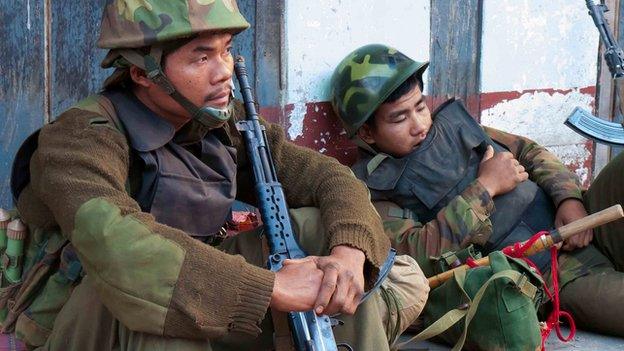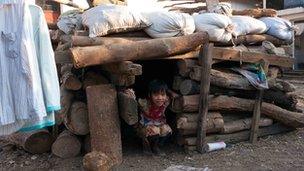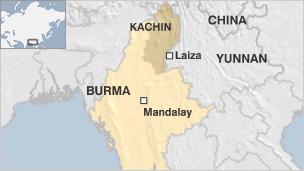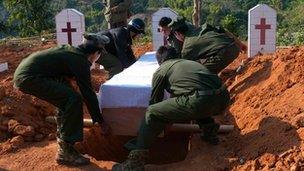Kachin rebels defiant on Burma's northern front line
- Published

Exhausted Kachin fighters back in Laiza after a hard day's fighting on their last hilltop stronghold
The little town of Laiza is very quiet now. Most of the shops are shut, the restaurants empty, and those who have not already fled are preparing to do so.
Nang Awng and her husband opened a restaurant four years ago.
Everything they own has gone into the business, but they have a truck in the backyard, loaded with food and clothes, ready to make the short drive across the river into China.
She has been terrified by the sound of shelling, clearly audible in Laiza, and the sight of Burmese military jets flying over.
One group is getting plenty of business. At the military cemetery in Laiza they are digging new graves every day for the Kachin soldiers being killed up on the hills outside the town.
I watched them bury 20-year-old Marip Brang Lat, hit by a rocket-propelled grenade on Hka Ya hilltop this morning.
I was on that hilltop just two days ago. Now it is being pounded by Burmese artillery.
We were taken to a fortified position a short distance away and, from the earthen trenches dug by the Kachin army, we listened to the crashing thump of mortar rounds hitting Hka Ya.
Sustained attack
Hundreds of Burmese troops were moving through the trees in the valley below us, climbing steadily to cut the supply road to the hilltop.

Laiza's residents have built shelters to protect themselves from Burmese bombs and shells
Only a handful of lightly armed Kachin soldiers defended the position, with a single, rusty recoilless rifle and one heavy machine-gun.
After that, there is nothing to stop the Burmese military rolling the last 3km (1.5 miles) into Laiza.
Burmese President Thein Sein has promised that the town will not be crushed. But those promises ring very hollow to the embattled Kachin, who point out that they have been under sustained attack, albeit no longer from the air, since the president announced a ceasefire on Friday.
In more than 50 years of fighting the Burmese state, the Kachin have been given ample grounds for mistrusting the words of its leaders.
Burmese soldiers have committed unspeakable atrocities on Kachin civilians. Even today, they have burned down a village they have taken.
Gulf of mistrust
There is no reason to doubt that the president is sincere in wanting an end to the wars with Burma's various ethnic rebel armies, which have continued intermittently ever since the country became independent in 1948.

The government and its new trading and donor partners in Europe and the US are all putting a lot of diplomatic effort into the search for peace.
Thein Sein has staked his presidency on moving Burma out of the dark years of isolation, and his ministers repeatedly state that an end to the country's internal conflicts is essential for this process to be successful.
However, there is a yawning gulf of mistrust to overcome, and a profound difference in how the Kachin Independence Organisation and the central government want negotiations to begin.
As a long-standing military man it is likely that Thein Sein shares the view that the government's priority must be to enforce national unity, to coax or coerce the minorities, who make up more than a third of the population, to accept a place within the union under the current constitution.
The KIO takes a view shared by other ethnic armies - the Karen, Karenni, Shan and others - that the Burmese state has never lived up to its promise, made around the time of independence, that big ethnic groups along Burma's borders would get a say in the structure of the state - that they would get to choose whether to stay in, or at least choose a federal political structure.

Marip Brang Lat, 20, is buried in Laiza's military cemetery, one of hundreds of Kachin soldiers killed in recent weeks
The KIO's precondition for negotiations is that they discuss a new, federal constitution.
It points out that the Burmese government has never controlled much of the territory in Kachin state. The central government is only interested in a ceasefire, and its proposal to fold the ethnic armies into the national armed forces.
Thein Sein is not the commander-in-chief of the Burmese military, and it is possible his ceasefire orders are being ignored by the generals.
Pyrrhic victory
It is just as likely that the military is using the vagueness in his pronouncements to grab as much ground as they can, leaving the KIO in such a weak position it will be forced to negotiate on the government's terms.
The Kachin position is certainly a great deal weaker than it was when the fighting resumed 19 months ago, after a 17-year ceasefire. As I write I can hear the occasional boom of artillery in the hills, and I have seen Kachin troops arriving back from the front, looking shattered.
They are, however, very devout Christians who see their struggle in moral terms, as right against might.
The KIO is a rather secretive and hierarchical organisation, with a sometimes inflexible chain of command that makes it slow to respond to changing circumstances.
Its forces are certainly outgunned by the well-equipped and well-trained Burmese.
They are fighting a defensive, trench war, trying to protect their territory, and the thousands of terrified people in it, rather than a guerrilla war, which might suit them better. But they are unquestionably brave, and determined to fight on, even if Laiza falls.
If that happens, it may prove to be a pyrrhic victory for the Burmese high command.
The war would probably drag on, robbing President Thein Sein of the peaceful new start he is promising his country, entrenching the power of the military in this strategic border area, and unnerving China, which sees Kachin state as a vital trade and energy corridor.
- Published20 January 2013
- Published26 May 2012
- Published6 December 2012